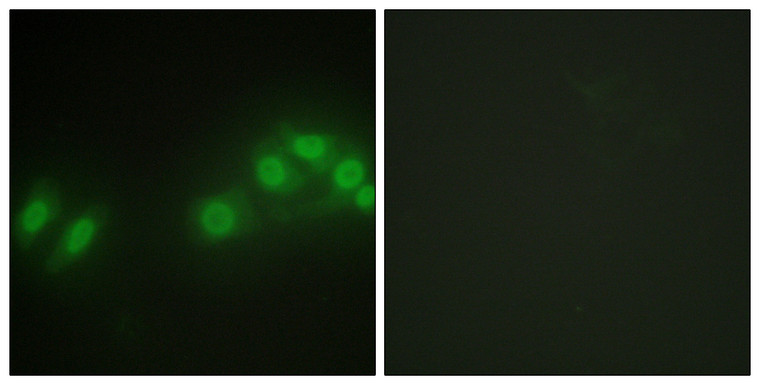| Host: |
Rabbit |
| Applications: |
IHC/IF/ELISA |
| Reactivity: |
Human/Mouse |
| Note: |
STRICTLY FOR FURTHER SCIENTIFIC RESEARCH USE ONLY (RUO). MUST NOT TO BE USED IN DIAGNOSTIC OR THERAPEUTIC APPLICATIONS. |
| Short Description: |
Rabbit polyclonal antibody anti-Serine/threonine-protein kinase LATS2 (541-590 aa) is suitable for use in Immunohistochemistry, Immunofluorescence and ELISA research applications. |
| Clonality: |
Polyclonal |
| Conjugation: |
Unconjugated |
| Isotype: |
IgG |
| Formulation: |
Liquid in PBS containing 50% Glycerol, 0.5% BSA and 0.02% Sodium Azide. |
| Purification: |
The antibody was affinity-purified from rabbit antiserum by affinity-chromatography using epitope-specific immunogen. |
| Concentration: |
1 mg/mL |
| Dilution Range: |
IHC 1:100-1:300IF 1:200-1:1000ELISA 1:20000 |
| Storage Instruction: |
Store at-20°C for up to 1 year from the date of receipt, and avoid repeat freeze-thaw cycles. |
| Gene Symbol: |
LATS2 |
| Gene ID: |
26524 |
| Uniprot ID: |
LATS2_HUMAN |
| Immunogen Region: |
541-590 aa |
| Specificity: |
Kpm Polyclonal Antibody detects endogenous levels of Kpm protein. |
| Immunogen: |
The antiserum was produced against synthesized peptide derived from the human LATS2 at the amino acid range 541-590 |
| Post Translational Modifications | Autophosphorylated and phosphorylated during M-phase and the G1/S-phase of the cell cycle. Phosphorylated and activated by STK3/MST2. Phosphorylation by NUAK2 may regulate its activity in phosphorylation and inactivation YAP1. |
| Function | Negative regulator of YAP1 in the Hippo signaling pathway that plays a pivotal role in organ size control and tumor suppression by restricting proliferation and promoting apoptosis. The core of this pathway is composed of a kinase cascade wherein STK3/MST2 and STK4/MST1, in complex with its regulatory protein SAV1, phosphorylates and activates LATS1/2 in complex with its regulatory protein MOB1, which in turn phosphorylates and inactivates YAP1 oncoprotein and WWTR1/TAZ. Phosphorylation of YAP1 by LATS2 inhibits its translocation into the nucleus to regulate cellular genes important for cell proliferation, cell death, and cell migration. Acts as a tumor suppressor which plays a critical role in centrosome duplication, maintenance of mitotic fidelity and genomic stability. Negatively regulates G1/S transition by down-regulating cyclin E/CDK2 kinase activity. Negative regulator of the androgen receptor. Phosphorylates SNAI1 in the nucleus leading to its nuclear retention and stabilization, which enhances its epithelial-mesenchymal transition and tumor cell invasion/migration activities. This tumor-promoting activity is independent of its effects upon YAP1 or WWTR1/TAZ. |
| Protein Name | Serine/Threonine-Protein Kinase Lats2Kinase Phosphorylated During Mitosis ProteinLarge Tumor Suppressor Homolog 2Serine/Threonine-Protein Kinase KpmWarts-Like Kinase |
| Database Links | Reactome: R-HSA-2028269 |
| Cellular Localisation | CytoplasmCytoskeletonMicrotubule Organizing CenterCentrosomeSpindle PoleNucleusColocalizes With Aurka At The Centrosomes During InterphaseEarly Prophase And CytokinesisMigrates To The Spindle Poles During MitosisAnd To The Midbody During CytokinesisTranslocates To The Nucleus Upon Mitotic Stress By Nocodazole Treatment |
| Alternative Antibody Names | Anti-Serine/Threonine-Protein Kinase Lats2 antibodyAnti-Kinase Phosphorylated During Mitosis Protein antibodyAnti-Large Tumor Suppressor Homolog 2 antibodyAnti-Serine/Threonine-Protein Kinase Kpm antibodyAnti-Warts-Like Kinase antibodyAnti-LATS2 antibodyAnti-KPM antibody |
Information sourced from Uniprot.org
12 months for antibodies. 6 months for ELISA Kits. Please see website T&Cs for further guidance








